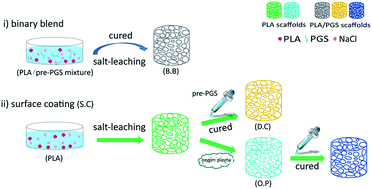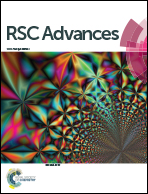Poly(glycerol sebacate)-modified polylactic acid scaffolds with improved hydrophilicity, mechanical strength and bioactivity for bone tissue regeneration
Abstract
Polylactic acid (PLA) has been extensively researched in biomedical engineering applications due to its superior mechanical strength and biocompatibility in vivo. But the inherent brittleness, slow degradability and inferior hydrophilicity greatly hamper its successful application. Here, a biodegradable crosslinked elastomer poly(glycerol sebacate) (PGS) was adapted to modify PLA scaffold for bone tissue engineering in this study. A highly interconnected and large porous, three-dimensional (3D) PLA-based scaffold was prepared by a NaCl particulate-leaching method and the PGS prepolymer (pre-PGS) was introduced either by pre-molding binary blend (B.B) or by surface coating (S.C) of a homogeneous PGS onto PLA-based scaffolds with and without oxygen plasma pretreatment (O.P and D.C). After curing at 130 °C, the resulting PLA/PGS scaffolds all exhibited well interconnected open-cell structures. The incorporation of PGS to PLA both by B.B and S.C could effectively improve the hydrophilicity, degradation, toughness and ductility, and the best efficacy was observed for the S.C with the oxygen plasma pretreatment. Specifically, at the ratio of PLA/PGS 9 : 1 and 7 : 3, the fracture strain of the PLA/PGS scaffolds by O.P were improved from 8% (pure PLA) to 13% and 24%, respectively. Further studies indicated that enhanced hydrophilicity and increased surface roughness were the main contributors to the above positive effect of oxygen-based plasma treatment. Additionally, these hybrid PLA/PGS scaffolds exhibited good mineralization, high cell biocompatibility, and enhanced cell adhesion and osteogenic differentiation for bone mesenchymal stem cells (BMSCs), especially for scaffolds by S.C. The present results suggest that the surface coating of PGS with oxygen-based plasma pretreatment is an effective strategy to modify the properties of PLA and the hybrid PLA/PGS scaffold represents a promising candidate in the formulation of bone tissue regeneration.


 Please wait while we load your content...
Please wait while we load your content...